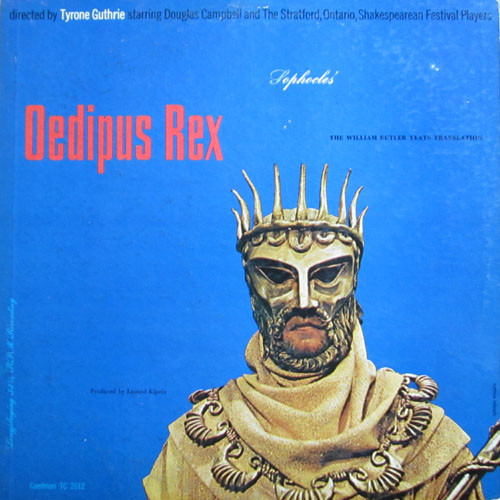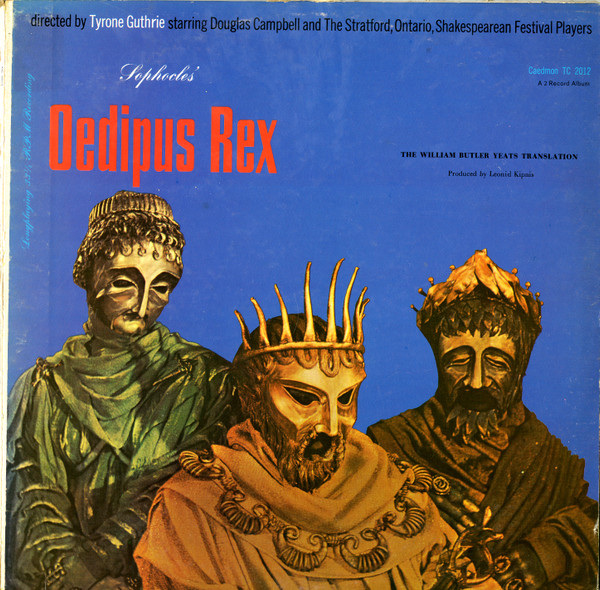Jacqueline Cundall
Created masks with Tanya Moisewitsch for Oedipus Rex (see below)
from Lawrance Bernabo
This version of “Oedipus Rex” is Sir Tyrone Guthrie’s famous 1957 production, which had the actors wearing masks just as the ancient Greeks did when first performing this classic tragedy by Sophocles. The masks, designed by Tanya Moisewitsch and Jacqueline Cundall, are slightly oversized and quite stylized: Oedipus (Douglas Campbell) wears a gold mask with a crown atop and a golden cloak; blind Tiresias (Donald Davis) appears entirely in white; each of the members of the chorus has a distinctive mask as one of the old men of Thebes. As befits the masks and costumes, there is a stylized formality to the acting. No one would argue that this is how the play was first performed in ancient Athens but it does suggest the general approach to Greek tragedy.
The story is well known to most audience, but attention should still be paid because the key to the Sophocles version of the tale is that the prophecy from Delphi that was told to the king and queen of Thebes is not the same that was told to Oedipus years later. A plague has come to Thebes and Creon (Douglas Rain) has returned from Delphi with word from Apollo. Creon is the brother to Jocasta (Eleanor Stuart), wife of Oedipus the king as she had been the wife of king Laius before him. He reports that the gods are angry that the murderer of Laius has not been brought to justice. Oedipus vows to do so and utters a curse upon the unknown killer. But when Oedipus demands that Tiresias reveal the identity of the killer, the blind prophet of Thebes says the king is the very man he seeks. Thus the primal crime of the man who killed his father and married his mother is reveal step by tragic step.
The English translation is by the poet William Butler Yeats, which provides its own touch of the classical for the language of the play, which has been cut down to 90 minutes for this filmed version (which is essentially of the stage production); there is also so additional dialogue, primarily an introduction by the Chorus that provides an introduction to Oedipus as the hero who bested the Sphinx and saved Thebes. There is also an introduction by an actor before the play that explains the basic idea of Greek tragedy and also draws a connection between the story of Oedipus and the Christian sacrament of communion. I like a more naturalistic approach, even with Greek tragedies, but there is something compelling about this particular production. Because this is a streamlined version of “Oedipus Rex,” viewers will get a good idea of the basic structure of a Greek play, and at 90-minutes in length you can show the film in two standard class periods.
Final Note: The part of the Priest in this Canadian production is played by a very young William Shatner, not that you can tell because he is wearing a mask. This is rather ironic given that the world would come full circle when a painted William Shatner/Captain Kirk mask was used by Michael Myers in the original “Halloween” film, which would sort of be a contemporary Greek tragedy in a lot of ways.
The story is well known to most audience, but attention should still be paid because the key to the Sophocles version of the tale is that the prophecy from Delphi that was told to the king and queen of Thebes is not the same that was told to Oedipus years later. A plague has come to Thebes and Creon (Douglas Rain) has returned from Delphi with word from Apollo. Creon is the brother to Jocasta (Eleanor Stuart), wife of Oedipus the king as she had been the wife of king Laius before him. He reports that the gods are angry that the murderer of Laius has not been brought to justice. Oedipus vows to do so and utters a curse upon the unknown killer. But when Oedipus demands that Tiresias reveal the identity of the killer, the blind prophet of Thebes says the king is the very man he seeks. Thus the primal crime of the man who killed his father and married his mother is reveal step by tragic step.
The English translation is by the poet William Butler Yeats, which provides its own touch of the classical for the language of the play, which has been cut down to 90 minutes for this filmed version (which is essentially of the stage production); there is also so additional dialogue, primarily an introduction by the Chorus that provides an introduction to Oedipus as the hero who bested the Sphinx and saved Thebes. There is also an introduction by an actor before the play that explains the basic idea of Greek tragedy and also draws a connection between the story of Oedipus and the Christian sacrament of communion. I like a more naturalistic approach, even with Greek tragedies, but there is something compelling about this particular production. Because this is a streamlined version of “Oedipus Rex,” viewers will get a good idea of the basic structure of a Greek play, and at 90-minutes in length you can show the film in two standard class periods.
Final Note: The part of the Priest in this Canadian production is played by a very young William Shatner, not that you can tell because he is wearing a mask. This is rather ironic given that the world would come full circle when a painted William Shatner/Captain Kirk mask was used by Michael Myers in the original “Halloween” film, which would sort of be a contemporary Greek tragedy in a lot of ways.


